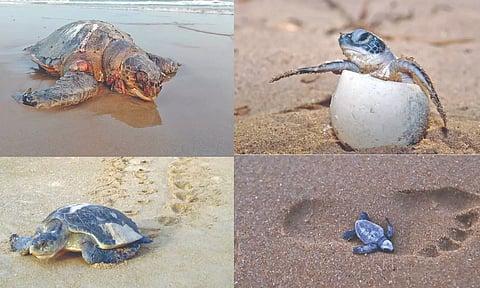Poor start to Olive Ridley season
CHENNAI: The dip in the number of Olive Ridley turtles arriving at the city beaches for the nesting season has sent alarmed conservationists in the city.
While the State Forest Department attributes the delay to the late onset of nesting season, conservationists point out a large number of turtles drowned while approaching the coast – thanks to unauthorised fishing nets.
Supraja Dharini, founder of TREE Foundation that works to preserve Olive Ridley turtles and other sea animals, said that an average of 150 nests would be found between Neelankarai to Alamparai. “But until February second week this year, fishermen and members of the Sea Turtle Protection Force of the organisation have identified around 60 nests only,” she added.
On the other hand, fishermen between the coasts have sighted 162 dead turtles washed ashore between Neelangarai and Alamparai this year. “The number of dead Olive Ridleys washing ashore is higher this year. While the ghost nets (abandoned fishing nets) kill a considerable number of turtles, thirukkai valai (nets used to catch ray fish) and kadamba valai (nets used to catch squids) are major contributors to Olive Ridley mortality,” lamented Supraja.
She pointed out that the eyes of the dead turtles were bulged out, suggesting possible drowning as a cause. Olive Ridleys have to come to the surface to breathe once every few minutes.
“When they get caught in ghost nets or other nets, they cannot reach the surface and drown to death,” she explained.
However, as per official data, 93 turtles washed ashore dead in the Chennai region, and 61 nests were seen. “Fishermen would install thirukkai valai and kadamba valai parallel to the coast to catch ray fish and squids. When the turtles approach the coast for nesting, they get caught in these nets and die. A kadamba valai is installed between 3 pm and 6 am, the time when the turtles try to reach the coast. Though there is a ban against using this particular net during the nesting season, it is not enforced. To prevent illegal usage of nets, the State government should seize them during the nesting season and hand them over to the fishermen after it’s over,” Supraja opined. Nesting season usually begins in December and ends in April-May.
Ironically, a kadamba valai would result in an average of 135 by-catches, including the Olive Ridleys, for every 10 squids. “Before approving new nets, Supraja urged the State government to study the impact of using these nets on the marine ecosystem as well as the food chain.
A fisherman from Sadras claimed that he had buried around 25 Olive Ridleys since the start of the season. In 2014, as many as 824 turtles had died due to trawl boats at Pennar Estuary. While the banned nets kill the turtles near the shore, gill nets used by large boats kill them at sea as the turtles swim close to the surface.
After the nesting season, the eggs are collected by the staff of the State Forest Department and volunteers, and taken to hatcheries, where they hatch after 45 days. Once hatched, they are released into the sea. Interestingly, an Olive Ridley would come to the same coast where it hatched 14 years ago. They lay the eggs there every alternate year.
It’s noteworthy that during last year’s nesting season, the forest department had released 1,83,497 hatchlings into the sea. As many as 35 hatcheries were set up, which is a huge bump from the 2016-2017 nesting season, in which only 74,196 hatchlings were released with only 19 hatcheries.
The number increased in 2021-2022 season, when 22 hatcheries were set up and 1.72 lakh hatchlings were released. In the current season, there are 44 hatcheries.
Surrounding temperature determines the gender of the hatchlings. The optimum temperature should be around 31-degree Celsius. If it’s between 25 to 30-degree Celsius, over 70% hatchlings will be male. If the temperature is maintained between 31 and 35-degree Celsius, more than 70% hatchlings will be female. Beyond 35-degree Celsius, the eggs will not hatch. And, out of the 1,000 hatchlings headed to the ocean, only one Olive Ridley would reach the age of laying eggs.
Speaking at a workshop on conserving endangered marine mega-fauna including Olive Ridleys, which was held in Thazhuthali Kuppam fishing village on Friday, Senthamizh Selvan, a fisheries department official, said, “Turtles eat sea grass; else, it will overgrow, which would negatively impact the fish resources of the sea.”
When asked Chief Wildlife Warden Srinivas R Reddy said that the nesting season has been delayed in the current year but hoped it would pick up pace. “The mortality numbers are usual. We’ll collect eggs from vulnerable areas only. If the nesting is present in the protected areas, we’ll keep them untouched and ensure the eggs are hatched naturally,” he added.

